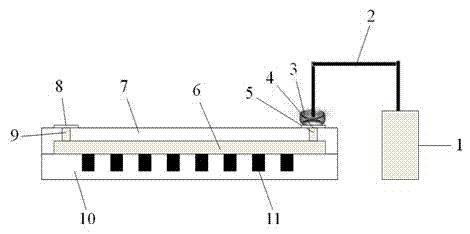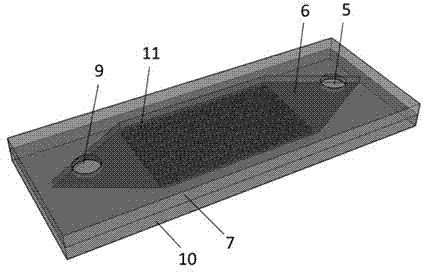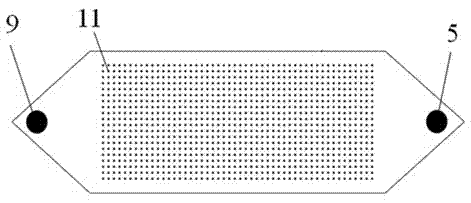High-density array chip device used for digital nucleic acid amplification
A nucleic acid and chip technology, applied in the field of detection devices in many fields, can solve the problems of unfavorable preparation methods and application costs, difficulty in entering ordinary laboratories, expensive chips and supporting instruments, etc., to reduce experimental costs, prevent external pollution, The effect of preventing cross-contamination
- Summary
- Abstract
- Description
- Claims
- Application Information
AI Technical Summary
Problems solved by technology
Method used
Image
Examples
Embodiment 1
[0034] Example 1 High-density glass chip device for digital nucleic acid amplification
[0035] 1-3, an integrated flow-circuit chip device for digital nucleic acid amplification, which consists of a vacuum system 1, a pipeline 2, a suction cup 3, a capping layer 7 and a reaction layer 10, the capping layer 7 and the reaction layer are composed of After the layer 10 is sealed, an integrated flow path chip assembly is formed. The two ends of the cover layer 7 are provided with a sample inlet 9 and a sample outlet 5. The reverse side of the cover layer 7 is an irregular hexagonal concave surface. 7. After being sealed with the reaction layer 10, a channel 6 is formed. The reaction layer 10 is provided with a high-density integrated reaction chamber 11 arranged in a matrix. The vacuum system 1 is connected to the suction cup 3 through the pipeline 2. The sample outlet 5 is connected to the vacuum system 1 through the suction cup 3 and the pipeline 2.
[0036] The reaction layer ...
Embodiment 2
[0041] Example 2 High-density single-crystal silicon chip device for digital nucleic acid amplification
[0042] The structure of the device is the same as that of Embodiment 1.
[0043] The reaction layer 10 is made of a polished single-crystal silicon wafer with a thickness of 500 μm, and a reaction chamber 11 is formed by photolithography and chemical wet etching. 50 μm, 100 μm, 200 μm, 300 μm. According to different widths and etching depths, the volume of the reaction chamber 11 can be 500 pL, 1 nL, 2 nL, 4.5 nL, 8 nL, 9 nL, 18 nL; the reaction chamber 11 can also be pentagon, rhombus, circle shape or other polygons.
[0044] The cover layer 7 can be selected from glass or transparent PMMA plate according to different applications. An irregular hexagonal concave surface with a length of 10 mm, a width of 4 mm and a depth of 50 μm, 100 μm, 200 μm or 300 μm is formed on the reverse side of the capping layer 7 by standard photolithography and etching techniques. When the ...
Embodiment 3
[0049] Example 3 Digital-Loop Mediated Isothermal Amplification (Digital-LAMP)
[0050] Samples were injected using the device of Example 1, and subsequent digital nucleic acid loop-mediated isothermal amplification was performed.
[0051] Specific steps:
[0052] 1. The structure of the channel is the same as that of Example 1, and the designed structure is printed on the film with an inkjet printer as a mask for lithography.
[0053] 2. The reaction layer 10 is made of glass with a thickness of 1 mm, and the reaction chamber 11 is made by standard photolithography and etching technology. The reaction chamber 11 is a square with side lengths of 100 μm, 200 μm or 300 μm, and a depth of 50 μm and 100 μm. or 200 μm; according to different widths and etching depths, the volume of the reaction chamber 11 can be 500 pL, 1 nL, 2 nL, 4.5 nL, 8 nL, 9 nL or 18 nL; the reaction chamber 11 can also be pentagonal, Rhombus or round.
[0054] 3. The cover layer 7 is made of 1 mm thick g...
PUM
 Login to View More
Login to View More Abstract
Description
Claims
Application Information
 Login to View More
Login to View More - R&D
- Intellectual Property
- Life Sciences
- Materials
- Tech Scout
- Unparalleled Data Quality
- Higher Quality Content
- 60% Fewer Hallucinations
Browse by: Latest US Patents, China's latest patents, Technical Efficacy Thesaurus, Application Domain, Technology Topic, Popular Technical Reports.
© 2025 PatSnap. All rights reserved.Legal|Privacy policy|Modern Slavery Act Transparency Statement|Sitemap|About US| Contact US: help@patsnap.com



